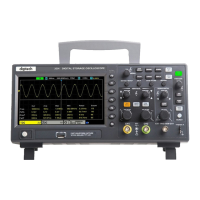User Manual
44
/
76
2. Press the Type softkey, and then turn the Multifunctional Knob to select one type.
3. Use the SaveTo softkey to external location. Press Save softkey and into File Manager interface.
4. Turn the Multifunctional Knob V0 to select the file or folder, press the Rename softkey, and then refer to the descriptions
in “Create a new file” to create a new file name.
2.10. Measure System
The oscilloscope displays graphs of voltage - time and can help to measure the displayed waveform. There are several ways
to take measurements, using the graticule, the cursors or performing an automatic measurement.
2.10.1. Scale measurement
Graticule: This method allows you to make a quick, visual estimate and take a simple measurement through the graticule
divisions and the scale factor.
For example, you can take simple measurements by counting the major and minor graticule divisions involved and
multiplying by the scale factor. If you counted 6 major vertical graticule divisions between the minimum and maximum
values of a waveform and knew you had a scale factor of 50mV/division, you could easily calculate your peak-to-peak
voltage as follows:
6 divisions x 50mV/division = 300mV.
2.10.2. Cursor measurement
Cursor: This method allows you to take measurements by moving the cursors. Cursors always appear in pairs and the
displayed readouts are just their measured values. There are two kinds of cursors: Amplitude Cursor and Time Cursor.
The amplitude cursor appears as a horizontal dotted line, measuring the vertical parameters.
The time cursor appears as a vertical dotted line, measuring the horizontal parameters.
The cursor measurement includes two modes: Manual mode and Tracking mode.
1. Manual mode:
Horizontal cursors or vertical cursors appear in pair to measure time or voltage, and the distance between the cursors can be
manually regulated. The signal source should be set as a waveform to be measured before the cursors are used.
2. Tracking mode:
A horizontal cursor is intersected with a vertical cursor to form a cross cursor. The cross cursor is automatically located on
the waveform, and the horizontal position of the cross cursor on the waveform is regulated by selecting “Cur A” or “Cur B”
and rotating the [UNIVERSAL] knob. The coordinates of the cursor point will be displayed on the screen of the oscilloscope.
Push the CURSOR button to display the Cursor Menu.
Select a measurement cursor and display it.
Select a waveform to take the cursor measurement.
Use the readouts to show the measurement.

